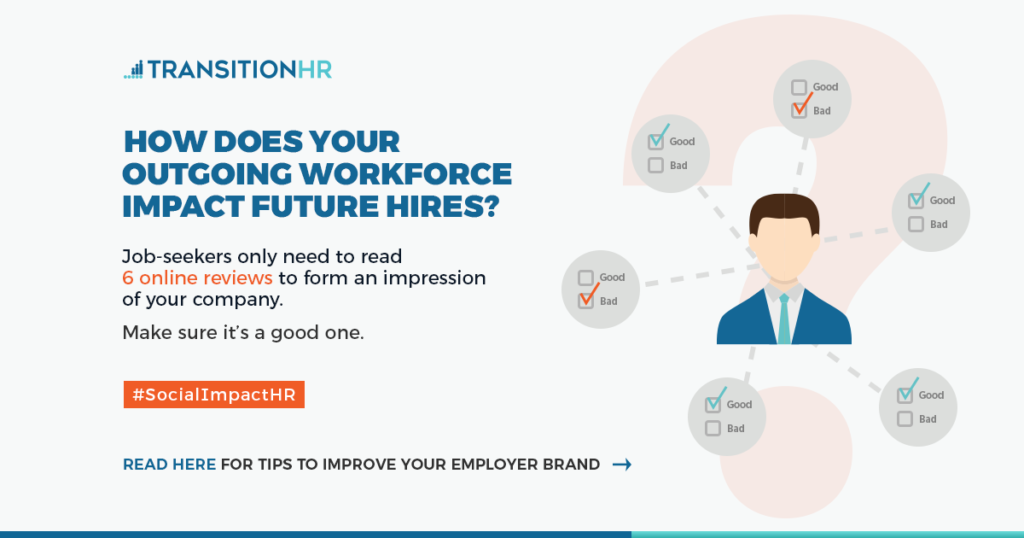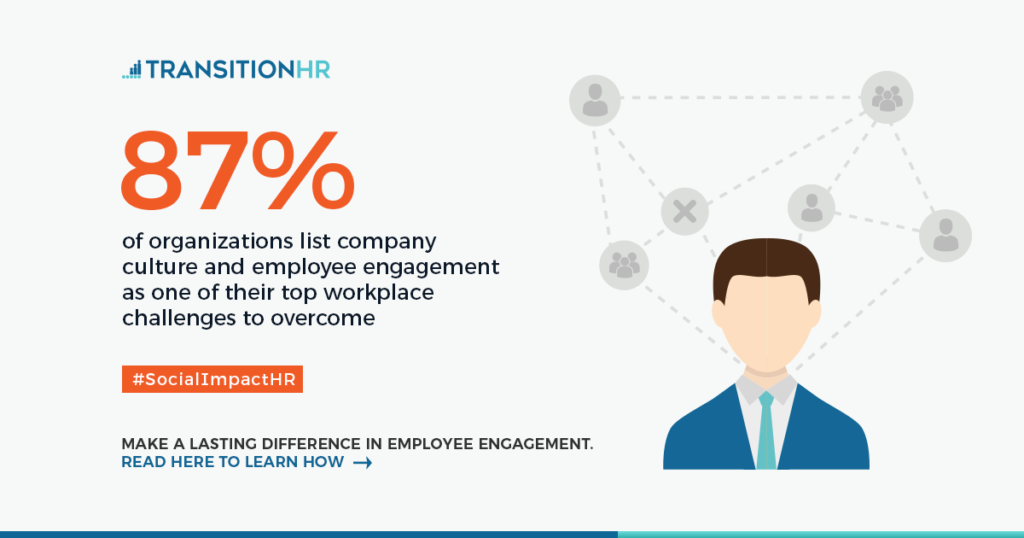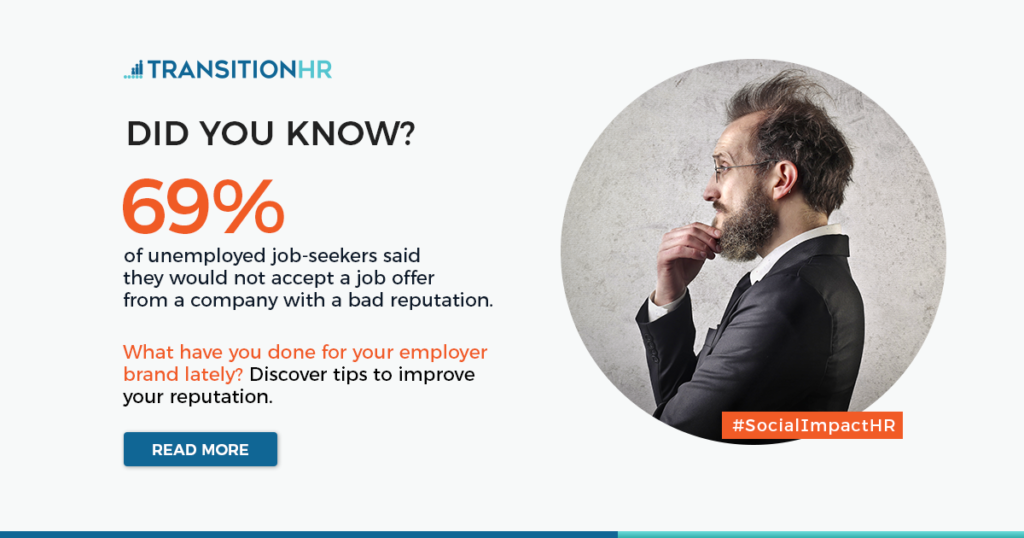In the age of information, little remains behind the proverbial closed door.
Take a look at your company reviews on Glassdoor, LinkedIn, Indeed, or Monster. Finished with those? Try Great Place to Work, Vault, or The Job Crowd.
With countless resources available, employees both past and present have multiple, anonymous ways to reveal your company culture, management tactics, professional practices, pay structure, interoffice relationships, workloads, and other operations.
With each review your company reputation, employer brand, and hiring capabilities are impacted. It takes a job-seeker only 6 reviews to form an impression of your organization based on what others have said. Among those potential candidates, 70% will use websites like Glassdoor to make an informed decision before they commit to their next career move.

With control shifting toward the job-seeker, potential hires have the ability to decide whether or not your company will be a good fit before you ever see their resume.
This changing power dynamic contributes to the favourable position job-seekers hold over the job-market as reported by employers and recruiters in a recent study. We have entered a “candidate-driven market” where the focus on employer recruitment priorities has shifted toward employee engagement, retention, company brand building, and strategic hiring.
In short, companies are jockeying to attract sought after candidates while ensuring their recruitment and management structure is optimized to retain new-hires after they are brought on.
To assist your company in the candidate-driven job-market, we have prepared a number steps to help you learn from your transitional workforce. These steps can improve your appeal as an employer while ensuring you hold on to valued employees.
Establish and cultivate a positive employer brand to manage the market perception of your organization.
A company identity continues to be a key consideration for potential candidates, with one-third of job-seekers saying brand and reputation is “very important” while evaluating a job prospect. A recent study of US workers led by Self Management Group (SMG) echoed this sentiment, with 63% of respondents saying they accepted a job offer because they believed in the mission or cause of a company.
Understand that a job-seeker may choose you not just for the position offered, but for who you are as a company. While competitive compensation remains most attractive to prospective hires, other intangible assets including company culture, office collaboration, camaraderie, and work-life balance rank highly according to employers. In select industries such as the healthcare field, workers are likely to accept less money for a better workplace culture.
If your company cannot compete on market salary, it’s important to differentiate your employer brand through these other methods. Look at your competitor workplace reviews online and identify trends. Typically, compensation (either good or bad) is quickly mentioned, while an office environment and the overall workplace atmosphere is elaborated on in much greater detail.
Use and react to this information. Make lasting changes internally to outperform your job-market competitors based on what their workers are telling you.
Past employees leave the majority of online workplace reviews. Get ahead of these assessments by gaining insight from your outgoing workers as they leave. Set in place a comprehensive exit-interview process to understand why candidates accepted your original offer, what kept them around, and why they are now leaving.
Data collected by SMG from over 1,400 web-based exit interviews shows that 68% of US workers leave within one year of accepting a new role. The same study found that 55% leave after only 6 months.
While unfortunate for recruiting, this quick turnover can ensure that you are collecting regular and recent data within your exit-interview process. Use this to proactively respond to negative factors and work toward improving the opinion workers leave with.
When satisfied, workers are happy to leave a positive recommendation of your workplace.
As it stands, your company is already in a good state among exiting employees according to the SMG study, with 75% of US respondents indicating that they’d recommend their past employer as a “good place to work”. It’s important to capitalize on this good will and improve the word of mouth generated around your company.
Recognize employee frustrations and respond accordingly.
Give your current employees multiple opportunities to voice their opinion and evaluate their engagement within your organization.
Across the US workforce there is room to improve employer-employee relations. A recent assessment on the American workplace shows that only 33% of US employees feel engaged at work.
At the top, organizations are well aware of this deficit, with 87% citing culture and engagement as one of their top workplace challenges to overcome. Worker engagement is a key contributing factor toward a positive employer brand.

By integrating employee pulse surveys, ongoing performance reviews, employee engagement initiatives, and other qualitative assessments at regular intervals, your HR team can quickly identify operational pain points. By working directly with these troubled workers and departments, a shift in company culture can begin to take place through an investment into appropriate solutions.
A recent study into human capital trends suggests employers elevate employee experience, designate senior leaders to own this process, embrace internal assessments, assess how other companies handle engagement, gain C-suite buy-in, and measure progression. All of these steps are in pursuit of a holistic approach toward employee engagement where human capital is effectively managed and seen as a worthwhile investment.
This internal investment has real return, with companies increasing year-over-year revenue by as much as 26% compared to those who have no formal employee engagement program in place.
Ignoring this will cost you.
There are direct financial costs attached to poor employer branding. As your company grows, these financial risk grow in comparison.
A recent study conducted by LinkedIn revealed that US organizations with 10,000 employees can expect to pay out $7.6 million in additional wages as a result of poor employer branding. This same study states that employers who do not invest in reputational branding could pay an additional $4,723 for each new employee hired.

Your performance in the job-market will take a direct hit too. When polled, 69% of unemployed job-seekers said they would not accept a job offer from a company with a bad reputation. In a candidate-driven market, applicants can afford to be choosey, and will be, when selecting their next employer.
- The online reputation your company holds directly impacts your hiring capability and performance in attracting top talent available in the job market.
- We are currently in a candidate-driven job market in which employers have put an increased emphasis on strategic hiring, retention, and employee engagement.
- A positive employer brand is highly sought after by job seekers. Identify steps toward improving company culture, office camaraderie, and the work-life balance for your staff.
- Influence the tone of the online reviews left by your employees. Gain insight from your current and outgoing workforce, make changes to head off recurring issues, and reap the reciprocal employer brand benefits as employees advocate on your behalf.
- There are proven financial repercussions that stem from a negative or underdeveloped employer brand.
Moving forward with employee engagement.
Following the steps laid out here is only a start toward improving employer brand and job-market performance.
What initiatives does your company have in place to improve talent acquisition? What are you doing to build your employer brand and company culture? How do you respond to worker feedback?
Reach out to us on Twitter @TransitionHR and let us know!

Access The Definitive Guide.
Confirm your contact information to download PDF ≥






